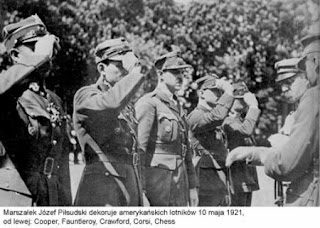A question:
Who is connected with all the following people and things: George Washington, American cavalry, Polish-Soviet war (1919-1921), King Kong, Battle of Britain, Cold War and honorary citizenship of the United States?
Hints:
HE saved the life of George Washington during the Battle of Brandywine. HE is called “the father of American Cavalry”. HE was mortally wounded during an assault in the siege of Savannah. HIS friend was Col. John Cooper. Apparently HE literally died in Cooper’s arms. HE was a Polish nobleman. HIS story was kept alive in the Cooper family. Col. John Cooper was the great, great, grandfather of Merian C. Cooper, who in 1933 directed and produced King Kong. Before that however Merian C. Cooper wanted to repay America’s debt to Polish heroes of the American War of Independence, especially because of HIS life sacrifice. So, after the end of World War I Merian C. Cooper went to Poland to work for the American Food Mission. After the Polish-Soviet war broke out in February 1919 Cooper wrote a letter to Poland’s Chief of State Józef Piłsudski, offering his services to the Polish Army. Cooper did not even insist on being a pilot and just wanted a duty “with fighting forces at the front”. Piłsudski reluctantly agreed, so Merian Cooper went to France and came back to Poland with 7 other American pilots, including Major Cedric Fauntleroy, who became the commander of the Kościuszko Squadron. Captain Merian C. Cooper became Fauntleroy’s second. Below is a picture of Cooper in Polish Air Force uniform.
The squadron was named after another double Polish-American hero Tadeusz Kościuszko. During the American War of Independence Kościuszko was the main military engineer, who designed very important defensive fortifications at Bemis Heights near Saratoga and at West Point. Thomas Jefferson, the principal author of the Declaration of Independence and Kosciuszko's close friend, called Kościuszko “the purest son of liberty that I have ever known, the kind of liberty which extends to all, not only to the rich”.
At the start the Kosciuszko squadron had only 8 American pilots, but in the following weeks more and more arrived. In all 21 Americans served in Polish Air Force during Polish-Soviet 1919-1921 war. There were also several Poles in the Kościuszko squadron and the whole ground crew was Polish. Below is a picture from September 1919 of the first 8 American Pilots who volunteered for the Polish Air Force. Front row from the left: Shrewsbury, Noble, Crawford and Kelly. Second row from the left: Clark, Fauntleroy, Cooper and Corsi.
The insignia of the Kościuszko Squadron were designed by Elliot Chess – one of the American pilots, who was a graphic designer by trade. He brought American and Polish elements together. The thirteen blue stars and white and red stripes represent the original American states. The crossed scythes re-forged as lances and a four-cornered hat with a feather represents Poland’s insurrection against Russia in the late 18th century which was led by Kościuszko.
On 7 May 1794 Kościuszko issued an act, in which he partially abolished serfdom in Poland, granted civil liberty to all peasants
and provided them with state help against the abuses by the nobility. It attracted many peasants to the ranks of the revolutionists hence
the re-forged scythes.
In 1920 the Kościuszko Squadron made over 400 combat flights. Polish land commanders highly valued the contribution of the Kościuszko Squadron. General Puchucki of the 13th Infantry Division wrote in a report: “The American pilots, though exhausted, fight tenaciously. During the last offensive, their commander attacked enemy formations from the rear, raining machine-gun bullets down on their heads. Without the American pilots’ help, we would long ago have been done for.”
By the end of the Polish-Soviet war 9 American Pilots and 3 Polish pilots serving with the Kościuszko Squadron were awarded with Poland's highest military decoration – Order of Virtuti Militari. Below is a picture of Józef Piłsudski decorating American Pilots. From the left are Cooper, Fauntleroy, Crawford, Corsi and Chess.
In 1925, four years after the end of the Polish-Soviet war, the Kościuszko Squadron was eventually renamed as 111th Fighter Squadron. When the World War II broke out 14 years later new pilots from this squadron fought, among other pilots, against the Germans over Poland and some of them later moved to Great Britain and became a part of the famous 303 Polish Squadron which played a very important role during the Battle of Britain in 1940. The 303 squadron’s full name was: No. 303 ("Kościuszko") Polish Fighter Squadron. It was named in honour of the Kosciuszko Squadron from the Polish-Soviet war, so in fact in honour of the American pilots. It even used the same insignia, but with the number 303 at the bottom.
During World War II Merian C. Cooper visited the 303 ("Kościuszko") Polish Squadron.
Let’s get back to HIM, who started it all. Two US Navy ships were named after HIM. One in 1858 and the other in 1964, during the Cold War. The second one was a nuclear-powered ballistic missile submarine. HE is also one of only seven people to be awarded honorary United States citizenship (in 2009).
Answer:
HE is Casimir Pulaski (Kazimierz Pułaski).
After his arrival to America, he wrote to George Washington:
“I came here, where freedom is being defended, to serve it, and to live or die for it.” He died for it.
https://www.badassoftheweek.com/pulaski
PS. Below there is a high-resolution picture of the letter sent by Merian C. Cooper to Józef Piłsudski. Click to enlarge!
(Tuesday, 30 July 2013)
Wednesday, 22 July 2015
Subscribe to:
Post Comments (Atom)







No comments:
Post a Comment